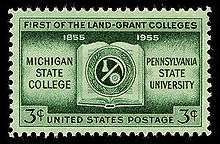History of Michigan State University
The history of Michigan State University (MSU) dates back to 1855, when the Michigan Legislature established the Agricultural College of the State of Michigan in East Lansing, with 3 buildings, 5 faculty members and 63 male students. As the first agricultural college in the United States, the school served as a prototype for future land-grant institutions under the Morrill Act enacted during Abraham Lincoln's presidency. The school's first class graduated in 1861 right after the onset of the American Civil War. That same year, the Michigan Legislature approved a plan to allow the school to adopt a four-year curriculum and grant degrees comparable to those of the University of Michigan (U-M).
In 1870, the College became co-educational and expanded its curriculum beyond agriculture into a broad array of coursework commencing with home economics for women students. The school admitted its first African American student in 1899. Not long before this, in 1885, the College had begun offering degrees in engineering and other applied sciences to students. The 26th U.S. President, Theodore Roosevelt, addressed the school at the 1907 commencement, an event coinciding with the 50th anniversary of the school's opening. During this period, the school established "Farmers' Institutes" as a means of reaching out to the state's agricultural community and informing the membership of developments in agricultural science; the program gradually became the MSU Extension Services.
After World War II, the college gained admission to the Big Ten Conference, joining the rival University of Michigan, and grew to become one of the largest educational institutions in the United States with over 50,000 students as of 2014.[3] In its centennial year of 1955, the state officially made the school a university and the current name was adopted in 1964 after Michigan voters adopted a new constitution. Today, Michigan State University emphasizes biotechnology research and residential college learning as a modern paradigm for America's land-grant institutions, of which it was the first.
Agriculture school
| Date | Name change |
|---|---|
| February 12, 1855 | Agricultural College of the State of Michigan |
| March 15, 1861 | State Agricultural College |
| June 2, 1909 | Michigan Agricultural College (M.A.C.) |
| May 13, 1925[5] | Michigan State College of Agriculture and Applied Science (MSC) |
| July 1, 1955 | Michigan State University of Agriculture and Applied Science (MSU) |
| January 1, 1964 | Michigan State University (MSU) |
The Michigan Constitution of 1850 called for the creation of an "agricultural school", either as a part of the University of Michigan, or as an autonomous institution.[6] U-M President Henry P. Tappan tried to convince the legislature to build the agriculture school in Ann Arbor, but the secretary of the Michigan State Agricultural Society, John C. Holmes, argued that the young farmers would not get the attention they needed in the established university. Holmes' argument eventually won out and, on February 12, 1855, Michigan Governor Kinsley S. Bingham signed a bill establishing the nation's first agriculture college, the Agricultural College of the State of Michigan.[7]
Classes began in May 1857 with three buildings, five faculty members, 63 male students, and a college president, Joseph R. Williams. Williams, a Harvard University Phi Beta Kappa, was a self-made gentleman farmer and prominent Michigan attorney. He was a passionate promoter of higher education for the farming and working classes. In the first year, Williams hired several well-educated faculty members who had studied in prominent east coast schools.[8] In cramped College Hall, these scholars developed well-equipped laboratories with then-rare microscopes and other state-of-the-art scientific equipment.[9] Under Williams, the College offered a unique blend of practical and theoretical academics.

With no prior American agricultural college on which to model itself, the College instead turned to the fledgling American medical school as a guide. In fact, a number of the early faculty members held medical degrees. As such, the school required more scientific study than other undergraduate institutions of the era.[10] The school offered a three-part curriculum that balanced liberal arts, science and practical vocational studies. Somewhat unusual for the day, Williams excluded Latin and Greek studies from the early curriculum. This meant that these classical languages were not admission requirements, a relief for the overwhelming number of rural applicants. The College did require three hours of daily manual labor, which helped students defray expenses and develop the campus infrastructure while students learned scientific principles through their efforts.[11]
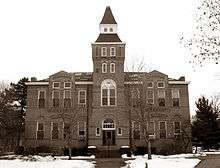
Despite these innovations, Williams ran into conflict with the managing State Board of Education. The Board saw the College as being elitist and extravagant, despite Williams' eloquent defense of higher education for the masses. Indeed, many farmers began protesting against the College's curriculum with some even calling for the College's abolition. They saw the Agricultural College's strong scientific curriculum as educating boys away from the farm.[12] So after just two years and under great public pressure, Williams resigned in 1859. The Board then reduced the curriculum to a two-year, vocation-oriented farming program,[13] a move that resulted almost overnight in a drastic reduction in enrollment.[14] The school was soon in dire financial straits and threatened with dissolution.
After resigning from the College, Williams was elected Michigan's lieutenant governor and helped pass the Reorganization Act of 1861. That new law mandated that the College have a four-year curriculum and the power to grant degrees comparable to those of the University of Michigan – that is, master's degrees (and, much later, doctoral degrees). Under the act, a newly created body known as the State Board of Agriculture took over from the State Board of Education in running the institution. At that time, the legislature adopted the more pronounceable name of State Agricultural College.[7]
The school's first class graduated in 1861, but there was no time for an elaborate graduation ceremony. The following year, U.S. President Abraham Lincoln signed the Morrill Land-Grant Colleges Act to support similar colleges nationally, the first instance of federal funding for education.[15] Williams, whose efforts as lieutenant governor had rescued the school from extinction, never witnessed this landmark occasion to which he had dedicated so much of his life, as he had become ill and died the year prior to the federal enactment.
Civil War and post-war period
| School year | Number of students |
|---|---|
| 1857–1858 | 63 |
| 1907–1908 | 1,100 |
| 1955–1956 | 44,836 |
In 1862 the newly created State Board of Agriculture appointed English Literature professor Theophilus Capen ("T.C.") Abbot president, much to the professor's surprise. Nevertheless, the soft-spoken Abbot remained president for twenty-two years and helped stabilize the College during and after the Civil War. One of the College's main concerns was that its Morrill Act endowment had attracted the University of Michigan's attention. Advocates for the University brought a bill before the State Legislature to merge with the Agricultural College and move the Lansing faculty and facilities to the Ann Arbor campus. UM leaders argued that it was necessary to share the Morrill Act income with the financially struggling UM. At least one influential pro-merger advocate appeared persuaded more by pure academic considerations than financial self-interest. Andrew Dickson White, Cornell University co-founder and first president, noted, “The State of Michigan . . . indeed gave its Agricultural College an excellent faculty and they have achieved much success considering their means but infinitely better would it have been to combine that Agricultural College with their noble University.” [17] While the plan initially had broad support across the state, merger opponents pointed out that Ann Arbor had inadequate facilities for an agricultural education; a move to Ann Arbor would require so much investment capital as to make the UM plan financially untenable. The Legislature voted down UM's proposal in 1863, but it returned to the floor in 1865, 1867, and again in 1869. While the College successfully fended off each takeover attempt, the persistent threat that it might move kept the Legislature from appropriating any money for new campus construction at Lansing. As a result, the College was restricted to one boarding hall and enrollment was accordingly limited for many years thereafter.[18]
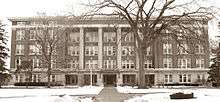
When President T. C. Abbot could not expand the size of the College during the 1860s, he focused on the quality of education. Abbot worked hard to perpetuate Williams' vision of a "whole man" educational approach. He took the College back to its original mixed liberal/practical curriculum taught by learned scholars. By the 1880s these included botany professor William J. Beal, an early plant geneticist who invented a hardier strain of hybrid corn through cross-fertilization. Beal corresponded with Charles Darwin and championed the laboratory, or "inductive", teaching method. He conducted his classes in the first botanical laboratory building on an American campus. Another distinguished faculty member was the alumnus-turned-professor, Liberty Hyde Bailey. Often called the "Father of American Horticulture",[19] Bailey was the first person to raise the study of horticulture to a science equal to botany. Other noteworthy 19th Century faculty included Walter B. Barrows, who was an internationally renowned ornithologist, while Rolla C. Carpenter (B.S. 1873) was a building construction specialist as well as an early HVAC engineer.
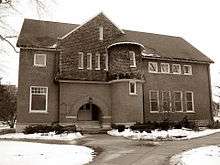
Although the school's then-isolated location limited student housing and enrollment during the 19th century, the College had a strong reputation and produced many distinguished alumni. While the institution emphasized scientific agriculture, its graduates went into a wide variety of professions. In the 1878 report of the State Board of Agriculture, President Abbot wrote that "Our graduates show that a love of knowledge has been infused into them by frequently returning to study or by resorting to other institutions of learning to continue their studies. They have gone from us to the University [of Michigan], to Cornell, Yale, Harvard, England, France and Germany to continue their studies." Abbot also identified alumni who were teaching at land grant schools such as Cornell and the University of Wisconsin–Madison, and at reputable liberal arts colleges such as Oberlin.[20]
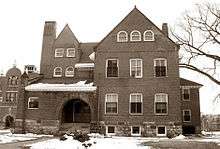
Notable 19th-century graduates include the aforementioned Bailey; Charles E. St. John, a prominent early 20th century astrophysicist who was an associate of Albert Einstein; Ray Stannard Baker, a famed turn of the 20th century "muckraker" journalist and Pulitzer Prize winning biographer of Woodrow Wilson; and William Chandler Bagley, a pioneering education reformer. In the 1870s, foreign students began traveling to the United States to attend the Michigan State Agricultural College such that, by the 1880s, they were a significant presence on campus. In 1887, two percent (six out of 312) of the College's student population were Japanese. Among the 1880s students were Michitaro Tsuda, (B.S.1884), who went on to become a member of the Japanese emperor's Privy Council, and Minakata Kumagusu, (1888), a prominent Japanese environmental scientist.[21]
While the College had many successful alumni, many of Michigan farmers still feared that a college education would dissuade their children from agriculture. President Abbot helped win them over by taking the College to the farm. In 1876 the Agricultural College held the first "Farmers' Institutes" in rural communities across the state, where school professors shared experimental and practical information with Michigan farmers. This concept led to the Hatch Act of 1887, which provided federal funding for agricultural experiment stations operated by each state's Land Grant college.[22] Through these "Farmers' Institutes" (now the MSU Extension),[23] T.C. Abbot converted many skeptical farmers into ardent College supporters.[24]
Coeducational college
The College first admitted women in 1870 but the school's relative isolation and lack of women's living quarters tamped coeducational enrollment for decades.[26] The few women who enrolled either boarded with faculty families or were locals who made the daily three-mile trek from Lansing by stagecoach over unpaved Michigan Avenue. The women were educated in the same scientific agriculture courses as men, excepting "practical agriculture." In 1896, the College became one of only fourteen other colleges and universities in America to adopt and meld a home economics curriculum within the liberal arts and sciences program, increasing female enrollment.[26] That same year, the school relocated male students from the old Abbot Hall dormitory to allow for greater a number of women to enroll in the course.[27]
In 1885, in order to fill out its mandate as a Morrill Act college, the College established a Mechanics program which became the College's first full-fledged, degree-granting engineering program.[28]
In 1899, the State Agricultural College finally admitted its first African American student, William O. Thompson. After graduation, Thompson taught at what is now Tuskegee University, founded and headed by Booker T. Washington. Washington later delivered one of his most memorable addresses to the class of 1900 at commencement: in the 1900 commencement address, Booker T. Washington said "Without industrial development there can be no wealth; without wealth there can be no leisure; without leisure, no opportunity for thoughtful reflection and the cultivation of the higher arts."[30] MSU President Jonathan L. Snyder had invited Washington to be the College's Class of 1900 commencement speaker. A few years later, Myrtle Craig became the first African-American woman to enroll at the College. Graduating with the Class of 1907, she received her degree from U.S. President Theodore Roosevelt, commencement speaker for the Semi-Centennial celebration of the College's opening.[7]

The City of East Lansing incorporated in 1907 as well.[31] Two years later, the college officially changed its name to Michigan Agricultural College (M.A.C.), since by this time there were many other agricultural colleges across the country. Even though the College had been around for over fifty years and was a widely recognized leader of the Land Grant Colleges, some within the state legislature opposed expansion. Despite the Morrill Act's original mandate that Land Grant Colleges teach engineering (then called "mechanic arts"), some in Michigan believed its agricultural college should not have engineering programs because these duplicated the University of Michigan's offerings. Nonetheless, M.A.C. had developed civil and electrical engineering programs to compliment the original mechanical program of 1885.[32] These separate disciplines were unified in a new Department of Engineering in 1908.[33]
When a 1916 fire destroyed M.A.C.'s nine-year-old engineering hall, there was a movement to have the entire program absorbed by the University of Michigan.[33] Lansing automobile magnate Ransom E. Olds, however, solidified the program on the East Lansing campus with a gift of $100,000 in 1917 for a new engineering building to be erected directly upon the foundations of the burned hall.[34] The donation, the College's first significant private gift for a building, resulted in Olds Hall. The original building is still standing but now houses MSU's University Relations division as well as classroom space.
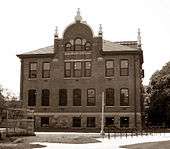
In 1914, the United States Congress passed the Smith–Lever Act, which provided federal funding for a system of state cooperative extension service. Like T.C. Abbot's initial "Farmers' Institutes", these extension services spread college-based knowledge about agriculture and related issues to citizens around the state. Such extension services served as the third prong of the Land Grant college mission of education, research and public service. With this new mandate, the College looked to expand its curriculum beyond agriculture and engineering. By 1925, the institution had expanded enough that it petitioned the state of Michigan to remove the word "agriculture" from its name, but the University of Michigan opposed the name change. As a compromise, the state government decided to call it Michigan State College of Agriculture and Applied Science (M.S.C.). However, the College's athletic teams were still known as the "Aggies". Thus M.S.C. held a contest to find a new nickname. They decided to call the teams the "Michigan Staters". Local sports writers for the Lansing State Journal and the Capital News went through the losing entries to find a shorter and more heroic name. They decided on the "Spartans". By coincidence, Justin Morrill had once compared the Land Grant colleges to the schools of ancient Sparta.[35] With a heroic name and a historic precedent, the "Spartans" quickly caught on as the teams' new nickname. Within a few years, the College changed the lyrics of the Fight Song to reflect the name change of the College and its sports teams.
Big Ten university
| Year | Winning team | Winning score | Losing team | Losing score |
|---|---|---|---|---|
| 1954 | Michigan State | 28 | UCLA | 20 |
| 1956 | Michigan State | 17 | UCLA | 14 |
| 1966 | UCLA | 14 | Michigan State | 12 |
| 1988 | Michigan State | 20 | Southern California | 17 |
| 2014 | Michigan State | 24 | Stanford | 20 |
In 1941, Secretary of the State Board of Agriculture John A. Hannah was appointed President of M.S.C. Hannah began the largest expansion in the school's history, aided by the G.I. Bill. Enacted in 1945, the law helped World War II veterans fund post-secondary educations. During this time the bulk of the South Campus was quickly built to allow for an ever-growing influx of students. One of Hannah's strategies was to build a new residence hall, enroll enough students to fill it and then use the income to start construction on a new dormitory. In the process the president built the nation's largest university housing system.[37] Under Hannah's plan, enrollment increased from 15,000 in 1950 to 38,000 in 1965.[38]
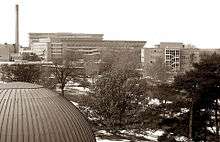
While Hannah was working on increasing the size of M.S.C.'s student body, he also expanded the school from a regional college to a nationally recognized research university. When the University of Chicago eliminated varsity football and withdrew from the Western Conference (now the Big Ten) in 1946, Hannah lobbied hard to take its place. The Big Ten finally admitted M.S.C. in 1949. After joining the conference, head football coach Clarence L. "Biggie" Munn led the Spartan football team to the Rose Bowl in the 1953–54 season, beating UCLA 28–20.[39] Successor coach Hugh "Duffy" Daugherty lead the football team to a second Rose Bowl where it again defeated UCLA, 17–14.[40]
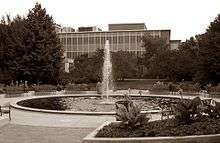
On the school's centennial year of 1955, the State of Michigan officially made the school a university. M.S.C. thus became Michigan State University of Agriculture and Applied Science. The State of Michigan did not allow the university to remove its "agriculture" moniker until the ratification of the Michigan Constitution of 1964. With this enactment, the university's governing body changed its name from the State Board of Agriculture to the Michigan State University Board of Trustees.[41] Since 1964, the school has been known simply as Michigan State University.
In the 1960s MSU expanded its reputation as a world-grant university, including responding to the invitation of Nigerian President Nnamdi Azikiwe to partner with Nigerians to build the first land-grant model university in Africa, the University of Nigeria at Nsukka.[42] The many years of faculty experience in Nigeria created the foundation for a major MSU African Studies Center.[43] By the 1990s MSU had the largest faculty in the nation of Africa specialists (170) and was producing more Ph.D.s on Africa, offering more study abroad in Africa (26), and teaching more African languages (30) than any other university. The faculty is deeply engaged in many African development problems in food security, health (especially tropical diseases such as malaria, river blindness, and filariasis), education, and gender equity. In 1978, MSU divested the stocks of companies doing business in apartheid-governed South Africa from its endowment portfolio.[44][45]
By 1969, the student body had become politically active over issues such as civil rights and the Vietnam War. Protests led to the resignation of President John A. Hannah and the blocking of the construction of Interstate 496 through the campus. In 1970, the Board of Trustees appointed President Clifton Wharton, MSU's first African-American president and the first minority president of a major public American university.[46] Under Wharton, the University created co-ed residence halls and residential colleges. In 1988, the university won its third Rose Bowl, this time beating USC 20–17.[47]
Post-Vietnam War and today
| President | Start year | End year |
|---|---|---|
| Joseph R. Williams | 1857 | 1859 |
| Lewis R. Fiske | 1859 | 1862 |
| Theophilus C. Abbot | 1862 | 1885 |
| Edwin Willits | 1885 | 1889 |
| Oscar Clute | 1889 | 1893 |
| Lewis G. Gorton | 1893 | 1895 |
| Jonathan L. Snyder | 1896 | 1915 |
| Frank S. Kedzie | 1915 | 1921 |
| David Friday | 1922 | 1923 |
| Kenyon L. Butterfield | 1924 | 1928 |
| Robert S. Shaw | 1928 | 1941 |
| John A. Hannah | 1941 | 1969 |
| Walter Adams | 1969 | 1970 |
| Clifton R. Wharton, Jr. | 1970 | 1978 |
| Edgar L. Harden | 1978 | 1979 |
| M. Cecil Mackey | 1979 | 1985 |
| John A. DiBiaggio | 1985 | 1992 |
| Gordon Guyer | 1992 | 1993 |
| M. Peter McPherson | 1993 | 2004 |
| Lou Anna K. Simon | 2005 | current |
As the pioneer land grant university, MSU has historically sought to provide educational opportunities to a wide variety of students, especially to those from the farming and working classes. Former President Peter McPherson stated "access to MSU and the education it offers is one of our roots" while noting the challenge, even irony, in maintaining such openness as the University's quality makes it ever more popular and difficult to be admitted into.[48] In the 2004 State of the University Address MSU President M. Peter McPherson stated: "At Michigan State, we are elite. But we are not elitist.".[49] In more recent years, "town and gown" relations have soured as students and permanent residents looked at each other with increasing hostility. This erupted in clashes involving the police in 1997,[50] 1998,[51] and 1999.[52] Local and national news referred to the disturbances as riots. After several years without any major incidents, another disturbance broke out on April 2, 2005, after the North Carolina men's basketball team defeated MSU in the 2005 NCAA Final Four.[53] Officially called a "civil disturbance," the ensuing violence sparked accusations of police brutality in East Lansing.
East Lansing's plan to redevelop Cedar Village (a student-dominated neighborhood at the center of several riots) has increased the tensions between the school and local government. In 2005, East Lansing City Council declared the neighborhood "blighted", and proposed to redevelop the 35 acres (14 ha) site as a complex of upscale condominiums and retail stores called East Village. Several fraternities in the affected area mounted a campaign against the redevelopment plan.[54]
Looking to improve its academic reputation in the 21st century, current president Lou Anna Simon called in September, 2004 for MSU to become the "global leader" of Land Grant institutions by the year 2012. These plans include creating a new residential college (the Residential College in Arts & Humanities), investing in biotechnology research,[55] and increasing National Institutes of Health donations above the $100 million mark.[56] As part of these plans the university sought and was awarded the Facility for Rare Isotope Beams by the Department of Energy in 2008.[57] The $550 million facility will study the properties of rare isotopes and better allow scientists to study origins of elements.[58]
References
- ↑ "Haines Photo Co., Conneaut, Ohio.". Library of Congress Prints and Photographs division, July 12, 1912. Retrieved April 14, 2007.
- ↑ Forsyth, Kevin S. (2003). "M.A.C. – Laboratory Row". A Brief History of East Lansing, Michigan. Retrieved September 11, 2009.
- ↑ Miller, Matthew. (2014). "MSU tops 50,000 students". Retrieved November 18, 2014.
- ↑ "MSU Facts". Michigan State University. Archived from the original on October 24, 2007. Retrieved August 25, 2012.
- ↑ Kuhn, Madison. (1955). Michigan State: The First Hundred Years, 1855–1955. East Lansing: Michigan State University Press. p. 305. ISBN 0-87013-222-9.
- ↑ "Michigan Constitution of 1850: Article 13, Section 1". Michigan Legislature. Retrieved August 25, 2012.
- 1 2 3 Widder, Keith (January 16, 2004). "Origins of MSU". MSU Sesquicentennial Celebration committee. Archived from the original on June 3, 2004. Retrieved August 25, 2012.
- ↑ Kuhn 1955, pp. 26, 31.
- ↑ Kuhn 1955, pp. 16, 27, 29.
- ↑ Kuhn 1955, pp. 26–7
- ↑ Darling 1950, p. 121.
- ↑ Darling 1950, pp. 123–25.
- ↑ Darling 1950, p. 129.
- ↑ Kuhn 1955, p. 32.
- ↑ "Backgrounder on the Morrill Act". Basic Readings in U.S. Democracy. US State Department. Archived from the original on April 11, 2007. Retrieved August 25, 2012.
- ↑ Founders' Day marks 150 years. MSU Today. February 10, 2005. Retrieved April 14, 2007. Archived January 18, 2006, at the Wayback Machine.
- ↑ White, Andrew Dickson (1869). N.Y. State Agricultural Society. Address on Agricultural Education, by Andrew D. White, President of Cornell University. (1869).
- ↑ Kuhn 1955, pp. 76–78.
- ↑ Hugo 1997, p. 68.
- ↑ The Seventeenth Annual Report of the Secretary of the State Board of Agriculture of the State of Michigan for the Year 1878, pp. 39, 40.
- ↑ Kuhn 1955, pp. 26–29.
- ↑ "Act of 1887 Establishing Agricultural Experiment Stations (Hatch Act)". Ohio Agricultural Research and Development Center. Archived from the original on February 7, 2007. Retrieved August 25, 2012.
- ↑ "MSUE Portal". Michigan State University Extension. Retrieved April 14, 2007.
- ↑ "Milestones Of MSU's Sesquicentennial". University Archives & Historical Collections. Retrieved April 14, 2007.
- ↑ "SESQUICENTENNIAL COVER STORY".
- 1 2 Momin 2002, p. 4.
- ↑ "Origins of MSU". MSU Sesquicentennial committee. Archived from the original on June 3, 2004. Retrieved August 25, 2012.
- ↑ "M.S. & PH.D. Programs in Electrical Engineering" (PDF). MSU Department of Electrical and Computer Engineering. August 2003. Archived from the original (PDF) on June 26, 2004. Retrieved August 25, 2012.
- ↑ Forsyth, Kevin S. (2003). "M.A.C. – Morrill Hall". A Brief History of East Lansing, Michigan. Retrieved September 11, 2009.
- ↑ Simon, Lou Anna Kimsey (February 12, 2005). "The Next Bold Experiment: A Land-Grant Revolution for the World". MSU Today. Archived from the original on March 10, 2005. Retrieved August 25, 2012.
- ↑ Miller 2002, p. 26.
- ↑ Kuhn 1955, p. 112–13, n. 6.
- 1 2 Forsyth, Kevin S. (2003). "Engineering Building". A Brief History of East Lansing, Michigan. Retrieved April 12, 2008.
- ↑ Rodriguez 2004, p. 117.
- ↑ Kuhn 1955, p. 305.
- ↑ Rose Bowl Games. College Football Data Warehouse. Retrieved April 14, 2007.
- ↑ Kiernan, Vincent. "Michigan State Asks Students to Turn Off Their Computers Over Winter Break". The Chronicle of Higher Education. January 2, 2003. Retrieved April 14, 2007.
- ↑ Heineman 1993, p. 21.
- ↑ "Yearly Bowl Games, 1953". College Football Data Warehouse. Retrieved April 14, 2007.
- ↑ "Yearly Bowl Games, 1955". College Football Data Warehouse. Retrieved April 14, 2007.
- ↑ "Michigan Constitution of 1963". Article VIII. Section 5. Retrieved April 13, 2007.
- ↑ "History of MSU Partnerships". MSU African Studies Center. Archived from the original on February 10, 2006. Retrieved August 25, 2012.
- ↑ http://africa.msu.edu/
- ↑ African Activist Archive
- ↑ U.S. Senate Committee on Banking, Housing, and Urban Affairs. (1985). The Anti-Apartheid Act of 1985. Washington: U.S. Government Printing Office. p. 213.
- ↑ Nixon 2004, p. 41.
- ↑ "1987 Yearly Bowl Games". College Football Data Warehouse. Retrieved April 14, 2007.
- ↑ McPherson, M. Peter. "Keep the Drive Alive". Michigan State University. September 24, 2002. Retrieved April 14, 2007. Archived June 7, 2011, at the Wayback Machine.
- ↑ Changing the World: The Revolution at 150. MSU Today. Retrieved April 14, 2007. Archived January 8, 2006, at the Wayback Machine.
- ↑ Terlep, Sharon. "E.L. turmoil angers city". The State News. September 9, 1997.
- ↑ Mullin, Greg. "17 arrested in weekend riot". The State News. May 4, 1998.
- ↑ Staff reports. "Thousands of revelers crowd streets in violent, fiery riot". The State News. March 28, 1999.
- ↑ Phillips, Lauren (April 4, 2005). "Police, student actions disputed". State News. Archived from the original on March 11, 2007. Retrieved September 1, 2012.
- ↑ Cendrowski, Scott (December 7, 2005). "FarmHouse and friends fight East Village plan". State News. Retrieved September 1, 2012.
- ↑ McMahon, Kathleen. "First Round of Life Sciences Corridor Funds Awarded". Michigan Economic Development Corporation press release. December 14, 2000. Retrieved April 13, 2007.
- ↑ Darrow, Bob (September 9, 2005). "Simon: MSU to be model university". State News. Archived from the original on August 14, 2007. Retrieved September 1, 2012.
- ↑ "MSU selected as site for $550 million Facility for Rare Isotope Beams". Retrieved February 16, 2010.
- ↑ "Welcome to FRIB". Retrieved February 16, 2010.
Bibliography
- Darling, Birt. (1950). City in the Forest; The Story of Lansing. New York: Stratford House. LCCN 50008202.
- Davis, Anderson (2005). Michigan State University: Off the Record. New York: College Prowler. ISBN 1-59658-083-6.
- Heineman, Kenneth J. (1993). Campus Wars: The Peace Movement at American State Universities in the Vietnam Era. New York: New York University Press. ISBN 0-8147-3512-6.
- Hugo, Nancy (1997). Earth Works: Readings for Backyard Gardeners. University of Virginia Press. ISBN 0-8139-1831-6.
- Kuhn, Madison. (1955). Michigan State: The First Hundred Years, 1855–1955. East Lansing: Michigan State University Press. ASIN B0007E4VX6.
- Momin, Shenila (2002). The History of Woman's Course at Michigan Agricultural College, 1896–1905, PDF Retrieved March 21, 2006.
- Nixon, Mark (2004). Journal of Our Times: 150 Years in the Life of Greater Lansing. Lansing, Michigan: Lansing State Journal. ISBN 1-932129-85-5.
- Miller, Whitney. (2002). East Lansing: Collegeville Revisited (Images of America). Charleston, South Carolina: Arcadia Publishing. ISBN 0-7385-2045-4.
- Rodriguez, Michael (2004). R.E. Olds and Industrial Lansing. Charleston, South Carolina: Arcadia Publishing. ISBN 0-7385-3272-X.
- Widder, Keith (2005). Michigan Agricultural College: The Evolution of a Land-Grant Philosophy, 1855–1925. East Lansing: Michigan State University Press. ISBN 0-87013-734-4.
External links
| Wikimedia Commons has media related to History of Michigan State University. |
Official Michigan State websites
- Main university site
- Michigan State University Museum
- MSU Archives & Historical Collections
- MSU Campus Buildings That No Longer Exist
- On the Banks of the Red Cedar Collections
- MSU Facts
Other websites
- A Brief History of East Lansing, Michigan includes a chronology of campus buildings during the M.A.C. years.
- Artifacts from Michigan Agricultural College – A private collection
- Association of American Universities website
- Morrill Act and related resources at the Library of Congress

